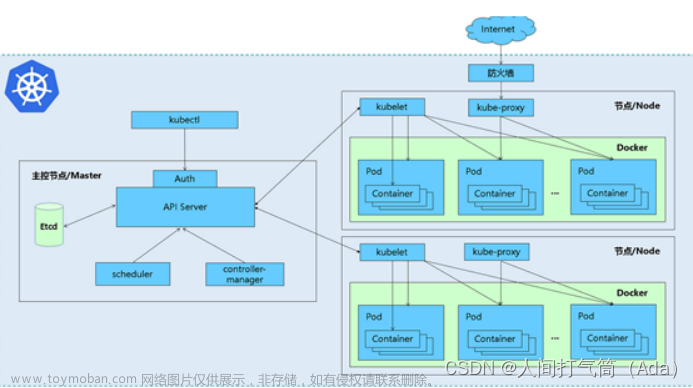-
前言
-
配置
-
健康检查
-
滚动更新
-
弹性伸缩
-
Prometheus集成
-
配置分离
-
-
汇总配置
-
业务层面
-
运维层面
-
前言
K8s + SpringBoot实现零宕机发布:健康检查+滚动更新+优雅停机+弹性伸缩+Prometheus监控+配置分离(镜像复用)
基于 Spring Boot + MyBatis Plus + Vue & Element 实现的后台管理系统 + 用户小程序,支持 RBAC 动态权限、多租户、数据权限、工作流、三方登录、支付、短信、商城等功能
项目地址:https://github.com/YunaiV/ruoyi-vue-pro
视频教程:https://doc.iocoder.cn/video/
配置
健康检查
-
健康检查类型:就绪探针(readiness)+ 存活探针(liveness)
-
探针类型:exec(进入容器执行脚本)、tcpSocket(探测端口)、httpGet(调用接口)
业务层面
项目依赖 pom.xml
<dependency>
<groupId>org.springframework.boot</groupId>
<artifactId>spring-boot-starter-actuator</artifactId>
</dependency>
定义访问端口、路径及权限 application.yaml
management:
server:
port: 50000 # 启用独立运维端口
endpoint: # 开启health端点
health:
probes:
enabled: true
endpoints:
web:
exposure:
base-path: /actuator # 指定上下文路径,启用相应端点
include: health
将暴露/actuator/health/readiness和/actuator/health/liveness两个接口,访问方式如下:
http://127.0.0.1:50000/actuator/health/readiness
http://127.0.0.1:50000/actuator/health/liveness
运维层面
k8s部署模版deployment.yaml
apiVersion: apps/v1
kind: Deployment
spec:
template:
spec:
containers:
- name: {APP_NAME}
image: {IMAGE_URL}
imagePullPolicy: Always
ports:
- containerPort: {APP_PORT}
- name: management-port
containerPort: 50000 # 应用管理端口
readinessProbe: # 就绪探针
httpGet:
path: /actuator/health/readiness
port: management-port
initialDelaySeconds: 30 # 延迟加载时间
periodSeconds: 10 # 重试时间间隔
timeoutSeconds: 1 # 超时时间设置
successThreshold: 1 # 健康阈值
failureThreshold: 6 # 不健康阈值
livenessProbe: # 存活探针
httpGet:
path: /actuator/health/liveness
port: management-port
initialDelaySeconds: 30 # 延迟加载时间
periodSeconds: 10 # 重试时间间隔
timeoutSeconds: 1 # 超时时间设置
successThreshold: 1 # 健康阈值
failureThreshold: 6 # 不健康阈值
滚动更新
k8s资源调度之滚动更新策略,若要实现零宕机发布,需支持健康检查
apiVersion: apps/v1
kind: Deployment
metadata:
name: {APP_NAME}
labels:
app: {APP_NAME}
spec:
selector:
matchLabels:
app: {APP_NAME}
replicas: {REPLICAS} # Pod副本数
strategy:
type: RollingUpdate # 滚动更新策略
rollingUpdate:
maxSurge: 1 # 升级过程中最多可以比原先设置的副本数多出的数量
maxUnavailable: 1 # 升级过程中最多有多少个POD处于无法提供服务的状态
优雅停机
在K8s中,当我们实现滚动升级之前,务必要实现应用级别的优雅停机。否则滚动升级时,还是会影响到业务。使应用关闭线程、释放连接资源后再停止服务
业务层面
项目依赖 pom.xml
<dependency>
<groupId>org.springframework.boot</groupId>
<artifactId>spring-boot-starter-actuator</artifactId>
</dependency>
定义访问端口、路径及权限 application.yaml
spring:
application:
name: <xxx>
profiles:
active: @profileActive@
lifecycle:
timeout-per-shutdown-phase: 30s # 停机过程超时时长设置30s,超过30s,直接停机
server:
port: 8080
shutdown: graceful # 默认为IMMEDIATE,表示立即关机;GRACEFUL表示优雅关机
management:
server:
port: 50000 # 启用独立运维端口
endpoint: # 开启shutdown和health端点
shutdown:
enabled: true
health:
probes:
enabled: true
endpoints:
web:
exposure:
base-path: /actuator # 指定上下文路径,启用相应端点
include: health,shutdown
将暴露/actuator/shutdown接口,调用方式如下:
curl -X POST 127.0.0.1:50000/actuator/shutdown
运维层面
确保dockerfile模版集成curl工具,否则无法使用curl命令
FROM openjdk:8-jdk-alpine
#构建参数
ARG JAR_FILE
ARG WORK_PATH="/app"
ARG EXPOSE_PORT=8080
#环境变量
ENV JAVA_OPTS=""\
JAR_FILE=${JAR_FILE}
#设置时区
RUN ln -sf /usr/share/zoneinfo/Asia/Shanghai /etc/localtime && echo 'Asia/Shanghai' >/etc/timezone
RUN sed -i 's/dl-cdn.alpinelinux.org/mirrors.ustc.edu.cn/g' /etc/apk/repositories \
&& apk add --no-cache curl
#将maven目录的jar包拷贝到docker中,并命名为for_docker.jar
COPY target/$JAR_FILE $WORK_PATH/
#设置工作目录
WORKDIR $WORK_PATH
> 基于 Spring Cloud Alibaba + Gateway + Nacos + RocketMQ + Vue & Element 实现的后台管理系统 + 用户小程序,支持 RBAC 动态权限、多租户、数据权限、工作流、三方登录、支付、短信、商城等功能
>
> * 项目地址:<https://github.com/YunaiV/yudao-cloud>
> * 视频教程:<https://doc.iocoder.cn/video/>
# 指定于外界交互的端口
EXPOSE $EXPOSE_PORT
# 配置容器,使其可执行化
ENTRYPOINT exec java $JAVA_OPTS -jar $JAR_FILE
k8s部署模版deployment.yaml
注:经验证,java项目可省略结束回调钩子的配置
此外,若需使用回调钩子,需保证镜像中包含curl工具,且需注意应用管理端口(50000)不能暴露到公网
apiVersion: apps/v1
kind: Deployment
spec:
template:
spec:
containers:
- name: {APP_NAME}
image: {IMAGE_URL}
imagePullPolicy: Always
ports:
- containerPort: {APP_PORT}
- containerPort: 50000
lifecycle:
preStop: # 结束回调钩子
exec:
command: ["curl", "-XPOST", "127.0.0.1:50000/actuator/shutdown"]
弹性伸缩
为pod设置资源限制后,创建HPA
apiVersion: apps/v1
kind: Deployment
metadata:
name: {APP_NAME}
labels:
app: {APP_NAME}
spec:
template:
spec:
containers:
- name: {APP_NAME}
image: {IMAGE_URL}
imagePullPolicy: Always
resources: # 容器资源管理
limits: # 资源限制(监控使用情况)
cpu: 0.5
memory: 1Gi
requests: # 最小可用资源(灵活调度)
cpu: 0.15
memory: 300Mi
---
kind: HorizontalPodAutoscaler # 弹性伸缩控制器
apiVersion: autoscaling/v2beta2
metadata:
name: {APP_NAME}
spec:
scaleTargetRef:
apiVersion: apps/v1
kind: Deployment
name: {APP_NAME}
minReplicas: {REPLICAS} # 缩放范围
maxReplicas: 6
metrics:
- type: Resource
resource:
name: cpu # 指定资源指标
target:
type: Utilization
averageUtilization: 50
Prometheus集成
业务层面
项目依赖 pom.xml
<!-- 引入Spring boot的监控机制-->
<dependency>
<groupId>org.springframework.boot</groupId>
<artifactId>spring-boot-starter-actuator</artifactId>
</dependency>
<dependency>
<groupId>io.micrometer</groupId>
<artifactId>micrometer-registry-prometheus</artifactId>
</dependency>
定义访问端口、路径及权限 application.yaml
management:
server:
port: 50000 # 启用独立运维端口
metrics:
tags:
application: ${spring.application.name}
endpoints:
web:
exposure:
base-path: /actuator # 指定上下文路径,启用相应端点
include: metrics,prometheus
将暴露/actuator/metric和/actuator/prometheus接口,访问方式如下:
http://127.0.0.1:50000/actuator/metric
http://127.0.0.1:50000/actuator/prometheus
运维层面
deployment.yaml
apiVersion: apps/v1
kind: Deployment
spec:
template:
metadata:
annotations:
prometheus:io/port: "50000"
prometheus.io/path: /actuator/prometheus # 在流水线中赋值
prometheus.io/scrape: "true" # 基于pod的服务发现
配置分离
方案:通过configmap挂载外部配置文件,并指定激活环境运行
作用:配置分离,避免敏感信息泄露;镜像复用,提高交付效率
通过文件生成configmap
# 通过dry-run的方式生成yaml文件
kubectl create cm -n <namespace> <APP_NAME> --from-file=application-test.yaml --dry-run=1 -oyaml > configmap.yaml
# 更新
kubectl apply -f configmap.yaml
挂载configmap并指定激活环境
apiVersion: apps/v1
kind: Deployment
metadata:
name: {APP_NAME}
labels:
app: {APP_NAME}
spec:
template:
spec:
containers:
- name: {APP_NAME}
image: {IMAGE_URL}
imagePullPolicy: Always
env:
- name: SPRING_PROFILES_ACTIVE # 指定激活环境
value: test
volumeMounts: # 挂载configmap
- name: conf
mountPath: "/app/config" # 与Dockerfile中工作目录一致
readOnly: true
volumes:
- name: conf
configMap:
name: {APP_NAME}
汇总配置
业务层面
项目依赖 pom.xml
<!-- 引入Spring boot的监控机制-->
<dependency>
<groupId>org.springframework.boot</groupId>
<artifactId>spring-boot-starter-actuator</artifactId>
</dependency>
<dependency>
<groupId>io.micrometer</groupId>
<artifactId>micrometer-registry-prometheus</artifactId>
</dependency>
定义访问端口、路径及权限 application.yaml
spring:
application:
name: project-sample
profiles:
active: @profileActive@
lifecycle:
timeout-per-shutdown-phase: 30s # 停机过程超时时长设置30s,超过30s,直接停机
server:
port: 8080
shutdown: graceful # 默认为IMMEDIATE,表示立即关机;GRACEFUL表示优雅关机
management:
server:
port: 50000 # 启用独立运维端口
metrics:
tags:
application: ${spring.application.name}
endpoint: # 开启shutdown和health端点
shutdown:
enabled: true
health:
probes:
enabled: true
endpoints:
web:
exposure:
base-path: /actuator # 指定上下文路径,启用相应端点
include: health,shutdown,metrics,prometheus
运维层面
确保dockerfile模版集成curl工具,否则无法使用curl命令文章来源:https://www.toymoban.com/news/detail-467523.html
FROM openjdk:8-jdk-alpine
#构建参数
ARG JAR_FILE
ARG WORK_PATH="/app"
ARG EXPOSE_PORT=8080
#环境变量
ENV JAVA_OPTS=""\
JAR_FILE=${JAR_FILE}
#设置时区
RUN ln -sf /usr/share/zoneinfo/Asia/Shanghai /etc/localtime && echo 'Asia/Shanghai' >/etc/timezone
RUN sed -i 's/dl-cdn.alpinelinux.org/mirrors.ustc.edu.cn/g' /etc/apk/repositories \
&& apk add --no-cache curl
#将maven目录的jar包拷贝到docker中,并命名为for_docker.jar
COPY target/$JAR_FILE $WORK_PATH/
#设置工作目录
WORKDIR $WORK_PATH
# 指定于外界交互的端口
EXPOSE $EXPOSE_PORT
# 配置容器,使其可执行化
ENTRYPOINT exec java $JAVA_OPTS -jar $JAR_FILE
k8s部署模版deployment.yaml文章来源地址https://www.toymoban.com/news/detail-467523.html
apiVersion: apps/v1
kind: Deployment
metadata:
name: {APP_NAME}
labels:
app: {APP_NAME}
spec:
selector:
matchLabels:
app: {APP_NAME}
replicas: {REPLICAS} # Pod副本数
strategy:
type: RollingUpdate # 滚动更新策略
rollingUpdate:
maxSurge: 1
maxUnavailable: 0
template:
metadata:
name: {APP_NAME}
labels:
app: {APP_NAME}
annotations:
timestamp: {TIMESTAMP}
prometheus.io/port: "50000" # 不能动态赋值
prometheus.io/path: /actuator/prometheus
prometheus.io/scrape: "true" # 基于pod的服务发现
spec:
affinity: # 设置调度策略,采取多主机/多可用区部署
podAntiAffinity:
preferredDuringSchedulingIgnoredDuringExecution:
- weight: 100
podAffinityTerm:
labelSelector:
matchExpressions:
- key: app
operator: In
values:
- {APP_NAME}
topologyKey: "kubernetes.io/hostname" # 多可用区为"topology.kubernetes.io/zone"
terminationGracePeriodSeconds: 30 # 优雅终止宽限期
containers:
- name: {APP_NAME}
image: {IMAGE_URL}
imagePullPolicy: Always
ports:
- containerPort: {APP_PORT}
- name: management-port
containerPort: 50000 # 应用管理端口
readinessProbe: # 就绪探针
httpGet:
path: /actuator/health/readiness
port: management-port
initialDelaySeconds: 30 # 延迟加载时间
periodSeconds: 10 # 重试时间间隔
timeoutSeconds: 1 # 超时时间设置
successThreshold: 1 # 健康阈值
failureThreshold: 9 # 不健康阈值
livenessProbe: # 存活探针
httpGet:
path: /actuator/health/liveness
port: management-port
initialDelaySeconds: 30 # 延迟加载时间
periodSeconds: 10 # 重试时间间隔
timeoutSeconds: 1 # 超时时间设置
successThreshold: 1 # 健康阈值
failureThreshold: 6 # 不健康阈值
resources: # 容器资源管理
limits: # 资源限制(监控使用情况)
cpu: 0.5
memory: 1Gi
requests: # 最小可用资源(灵活调度)
cpu: 0.1
memory: 200Mi
env:
- name: TZ
value: Asia/Shanghai
---
kind: HorizontalPodAutoscaler # 弹性伸缩控制器
apiVersion: autoscaling/v2beta2
metadata:
name: {APP_NAME}
spec:
scaleTargetRef:
apiVersion: apps/v1
kind: Deployment
name: {APP_NAME}
minReplicas: {REPLICAS} # 缩放范围
maxReplicas: 6
metrics:
- type: Resource
resource:
name: cpu # 指定资源指标
target:
type: Utilization
averageUtilization: 50到了这里,关于SpringBoot + K8S 中的滚动发布、优雅停机、弹性伸缩、应用监控、配置分离的文章就介绍完了。如果您还想了解更多内容,请在右上角搜索TOY模板网以前的文章或继续浏览下面的相关文章,希望大家以后多多支持TOY模板网!












